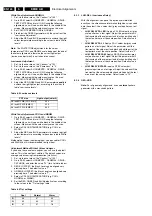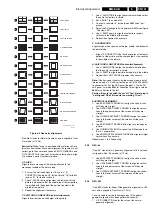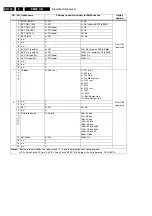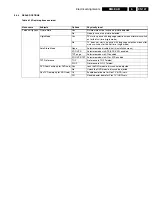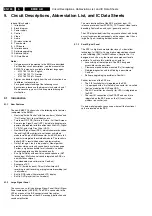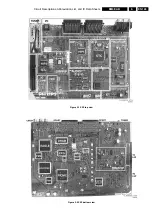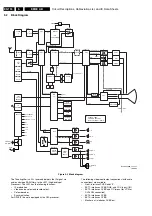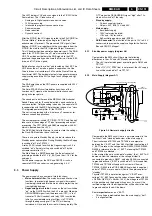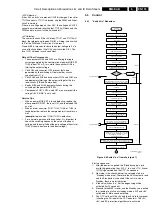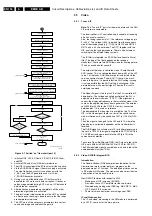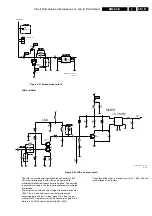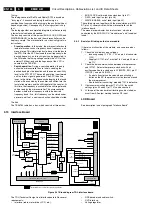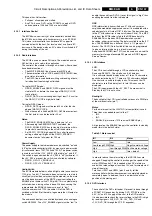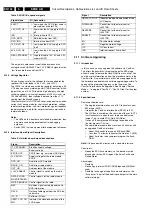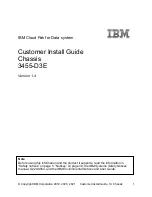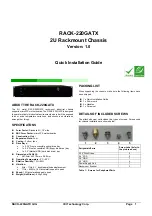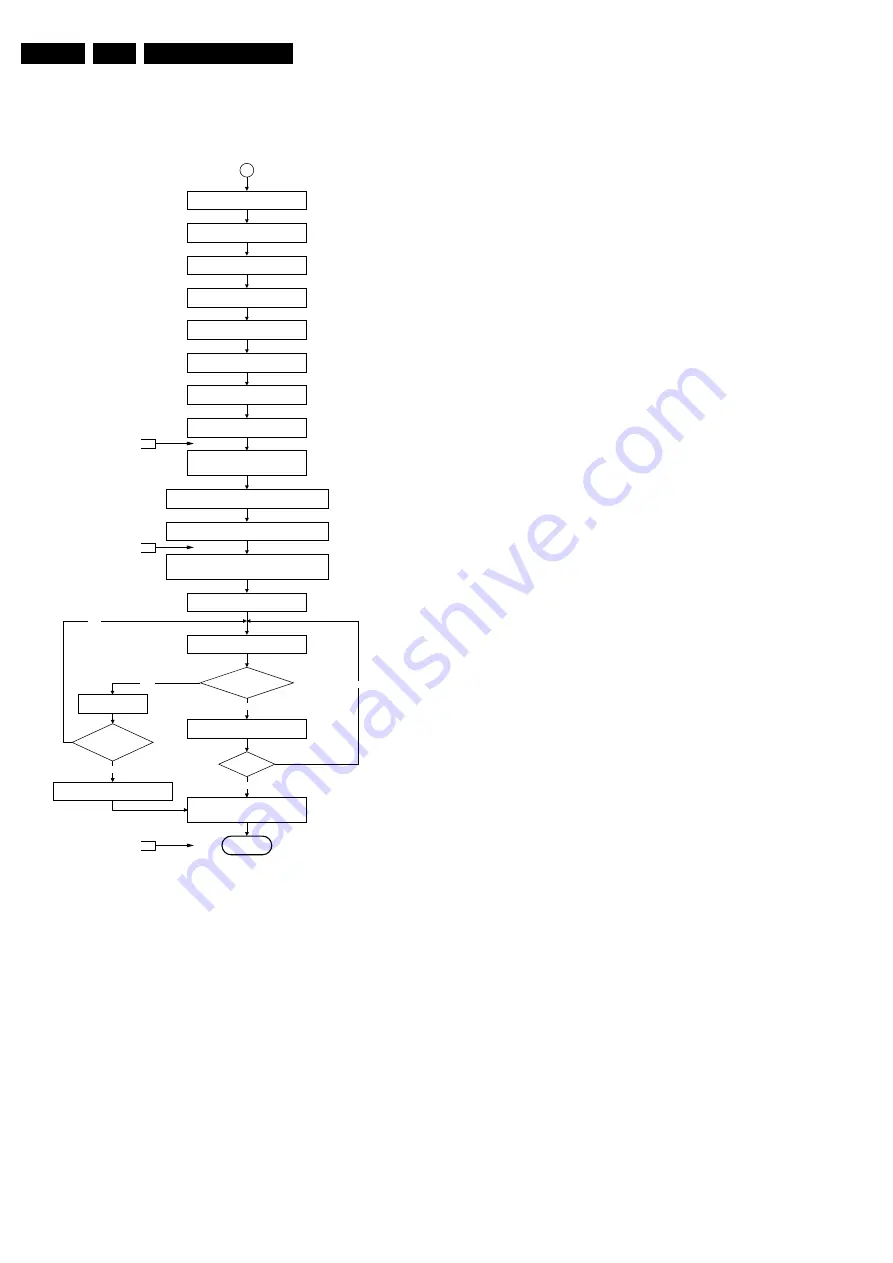
Circuit Descriptions, Abbreviation List, and IC Data Sheets
9.
Figure 9-7 Switch "on" flow chart (part 2)
1.
Initialise HOP, HIP, 3D Comb, PICNIC, PIP/DW, Tuner,
and MSP.
2.
Activate HFB and X-ray (USA only) protections.
3.
The HOP is instructed via the I2C-bus to start the line drive.
4.
Via the SUP-ENABLE signal, the main supply is activated.
The Line Deflection circuitry is supplied now with the
V_BAT, and the EHT generation can start. Also,
V_SOUND becomes available.
5.
During start-up of the deflection, I2C traffic must be
disabled for 250 ms to avoid data corruption. If flashes or
spikes are generated during EHT start-up, I2C data could
be disturbed or corrupted.
6.
After deflection is powered up completely, all the other
protection-algorithms are activated.
7.
The black current stabilisation loop in the HOP is switched
on. Some extra checking is done to ensure that the loops
are completely stabilised.
8.
The OTC sets all the necessary parameters for a correct
sound and image and unblanks the picture.
9.5
Video
9.5.1
Tuner & IF
Note: The "Tuner & IF" parts for the main picture and the DW/
PIP picture are comparable.
The tuner/splitter is I2C controlled, and is capable of receiving
off-air and cable channels.
Also, the tuning is done via I2C. The reference voltage on pin
9 is 33 V. This voltage (+33V) is derived from the secondary
side of the standby supply (V_TUN), via D6110 and R3116//
R3115 and a 33 V zener diode. The OTC, together with the
HIP, controls the tuning procedure. There is also automatic
switching for the different video systems.
The IF-filter is integrated in a SAW (Surface Acoustic Wave)
filter. The type of this filter depends on the received
standard(s). There are two SAW filters: one for filtering picture-
IF and a second one for sound-IF.
The output of the tuner is controlled via an IF-amplifier with
AGC-control. This is a voltage feedback from pin 62 of the HIP
to pin 1 of the tuner. AGC take-over point is adjusted via the
service alignment mode "Tuner AGC". If there is too much
noise in the picture, it is possible that the AGC setting is wrong.
It is also possible that the AGC-setting is misaligned, if the
picture deforms with a perfect signal. Then the IF-circuit is
amplifying too much.
The video IF-signal is fed to pins 2/3 of the PLL-controlled IF-
demodulator. The voltage-controlled oscillator of the PLL is
adjusted via the service menu "IF AFC". If the alignment is
correct, the displayed frequency in the installation menu is the
same as the applied frequency from a generator. The external
coil L5408 (or L5P08 for the DW/PIP circuitry), connected
between pins 7/8, is used as reference.
The demodulated IF-video signal is available at pin 10 of the
HIP. In this video signal, there is a rest of the sound carrier,
which is filtered out by the sound trap 1407 (or 1P09 for DW/
PIP).
Then the signal is fed again to the HIP on pin 12, where the
group delay is corrected, dependent on the standard that is
received.
The CVBS-signal is available at pin 13 for further processing in
the set. Via TS7322, the signal is supplied to EXT1 (SCART pin
19, CVBS out) and again back into the HIP (pin 14) to the
source/record selection.
To achieve Quasi Split Sound (QSS), the IF-signal is fed to the
HIP on pin 63/64 via SAW-filter 1409 (or 1P04 for DW/PIP).
The FM-modulated signal is available on pin 5 and is fed to the
audio demodulator (item 7A02).
9.5.2
Video: DW/PIP (diagram B15)
Introduction
The Double Window (DW) panel provides the option for the
viewer to see two (or more) pictures / programs on the
displayed area of a TV screen. The displayed pictures can be
in PIP mode or DW mode. The viewer can also select the size
and position of the "second" picture.
New DW/PIP features with respect to 2002:
•
Making use of HIP instead of BOCMA.
•
Provisions to use 2D Comb filter for the sub-picture.
•
New modes by making use of FBX (e.g. Multi-PIP 12, Multi-
PIP 9, Multi-PIP 8 surround).
•
Photo finish in correct order by making use of FBX.
IF and Video section
The "IF and video" processing in the DW module is performed
by a HIP IC, same as for the main picture.
CL 36532008_125.eps
080503
Initialise PICNIC
Initialise rest of PIP/DW module
(MUPPET already initialised)
Initialise tuner
Start TXT acquisition
Initialize TDL
Start video recogn HDD
deactivate reset MSP and
initialise MSP
detect and initialise wireless Module
(Power up sequence)
set_standby_mode_HOP = Normal
activate HFB and X-ray (US only)
protection 600ms later
HOP starts linedrive; Linedrive switches on the main
supply; Vbatt, Vsound become available
EHT generation starts; NO I
2
C during 250ms after
set_standby_mode_HOP is switched to NORMAL
ON
Start 30s timer
wait 200ms
Increase counter
(CR 433) Report
BlackCurrentLoopError
Counter = 0
Set_user_settings,
demute,
set_rgb_blanking = OFF
End of freerunning PLL;
HOP: set_sync_mode = active
set_black_current_stabilisation = one_point_control
No
No
No
Yes
Yes
Counter = 11
Time out of
30 seconds
reached
Get_black_current_failure
= FAIL
Yes
Trapped Startup 3
Trapped Startup 4
Trapped Startup 5
A

